

Exploring our past to sort out myth from reality
Share this Page on
Facebook or Twitter

These are the voyages of the TimeShip Anachron.
Our Mission: To boldly explore the past, dispelling
mythinformation and mythconceptions
of American History along the way.
.
 Visit us on Facebook
Visit us on Facebook
Meet MythAmerica Series

Pt 1 Pt 2 Pt 3 Pt 4 Pt 5 Pt 6 Pt 7 Pt 8
Not So Fabulous Fifties, Part 7
Disney-fied Nostalgia
A law was made a distant moon ago here:
July and August cannot be too hot.
And there’s a legal limit to the snow here in Camelot.
The winter is forbidden till December and exits March the second on the dot.
By order, summer lingers through September in Camelot.
Camelot! Camelot! I know it sounds a bit bizarre,
But in Camelot, Camelot that’s how conditions are.
The rain may never fall till after sundown. By eight, the morning fog must disappear.
In short, there’s simply not a more congenial spot
For happily-
…The snow may never slush upon the hillside. By nine p.m. the moonlight must appear.
In short, there’s simply not
A more congenial spot
For happily-
(“Camelot” from the musical Camelot, sung by Richard Harris)
When my grandson Jonathan was 11 years old, our family went to Walt Disney World in Florida, for the first time since he was a toddler. Early in our visit, we had just strolled down Main Street USA in the Magic Kingdom, and as we sauntered on toward the Castle he commented, “It is so peaceful and beautiful here! I want to build something exactly like this back home!”
As you can tell by Jonathan’s comment, Walt did his job well. For Main Street USA at Disneyland in California he and his team of “Imagineers” essentially “recreated” an idyllic piece of his turn-

And it was really authentic—the Imagineers who plan such things leave nothing to chance. Well, authentic in one sense of the word. For the buildings themselves weren’t really modeled on the buildings in Marceline. The Imagineers weren’t recreating Walt’s specific memories—they were recreating “the feel” of his idealized memories. Walt, who was born in 1901, lived in Marceline from 1906 to 1910. So this 1909 postcard of Marceline shows exactly what it looked like when he lived there.
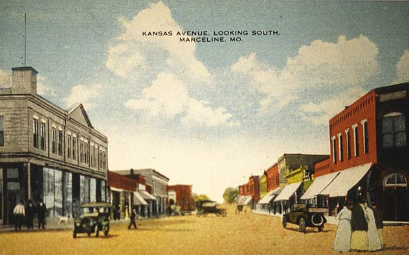
Somehow it doesn’t quite look like the Disneyfied version! No spanking clean, wide cobblestone walkways to stroll by the shops. And it’s quite likely that the street you see here was just plain ol’ dirt. With dust whirling up to choke you in the miserably hot Missouri summertime, and turning to a nasty mud and slush in rainy and snowy seasons that would make a mess of the hems of those long dresses you see in the pic.
Noting the dog in the pic, I’ll bet there were dog droppings on the ground everywhere (pooper-
There would be no air conditioning inside those buildings when temps got up into the 100s.
No, the Disney Imagineers had no desire to actually clone a dusty old Missouri town and make it the centerpiece of their splendiferous theme park. They took the emotional feelings Walt had about this part of his youth, and created a setting worthy of them.
And the result was essentially…Camelot. A place that never existed either.
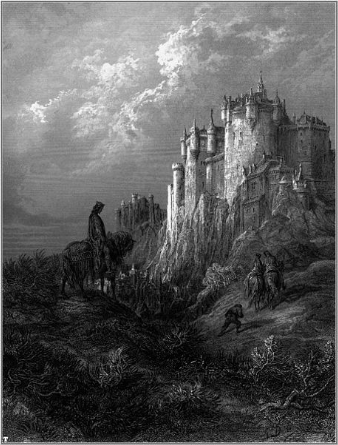
Actually, I didn’t invent the word Disneyfied in the title of this section. Disneyfication is a recently coined term actually used in books by social scientists to indicate when something in the real world, that has flaws and blemishes, is recreated in such a way that all those flaws and blemishes have been figuratively “air-
Wikipedia: Disneyfication (also called Disneyization)
They can be used more broadly to describe the processes of stripping a real place or event of its original character and repackaging it in a sanitized format. References to anything negative are removed, and the facts are watered down with the intent of making the subject more pleasant and easily grasped. In the case of places, this typically means replacing what has grown organically over time with an idealized and tourist-
The real world has mosquitoes and litter and peeling paint and pollution and hostile people and animals. Not so Disney’s theme parks. See someone toss a gum wrapper on the ground? Turn away for a second and a “cast member” (as employees are called) will swoop in out of nowhere, dispose of it, and disappear by the time you turn back around. Where do they disappear to? If it’s time for a break, they pop down a hidden entrance to the Utilidor (“utility corridor”) passageways and rooms that criss-

All surfaces throughout the Magic Kingdom, whether walls or signs or whatever, always look freshly painted and polished, because once they have the slightest dulling from wind or rain or sun, they ARE freshly repainted or polished. (The rumor that hitching posts on Main Street are repainted EVERY night is likely an exaggeration …but not by much.)
If you visit the international area around the lagoon at Walt Disney World’s Epcot, you will get a taste of various “nations,” but it will be a homogenized, sanitized, non-

I bring Disneyfication up because I believe it to be something that Americans do to their memories of the past, especially the older they get. Sometimes their own personal past, but just as often the past of their nation.
Before I continue commenting, let me make one thing perfectly clear. I am an American. I am grateful to God that I live in America. I would not choose to live anywhere else. I am proud and grateful for the accomplishments and sacrifices of many people throughout its history who have made the nation and the world a better place.
And I have some nostalgia for limited aspects of that history myself. But I feel no compulsion from God to Disney-
I bring all this up because I frequently get CCMails, or read posts in my Facebook Friend Feed, that express sentiments that I don’t share. I call them “Ain’t it a shame” rants. The basic gist of them goes something like this …
“Ain’t it a shame how rotten young people are these days? They have no respect for their elders. It was different when I was young! Why can’t they be like we were? God says in the Bible that in The End children will be horribly disrespectful—we are obviously there now! Jesus is definitely coming soon because it can’t get any worse.”
“Ain’t it a shame that our country is so immoral these days? Society was so much more wholesome when I was young. Why can’t we go back to the way it was in the 1950s, when God was in the schools, Dad was the head of the Family, and people believed in and lived by the Ten Commandments? The Bible said there would come a time like this—Jesus is definitely coming soon because it can’t get any worse.”
“Ain’t it a shame that America is no longer the great nation it used to be? God blessed us with great prosperity. We made the world safe for democracy. We were like the biblical “City on a Hill”—because our culture and institutions had been so clean and pure and noble. We all looked forward to achieving the American Dream of material abundance for all! That’s what it was like when I was young…not like now. Jesus is definitely coming soon because it can’t get any worse.”
What they don’t seem to realize is that folks were saying the same thing back in the '50s!
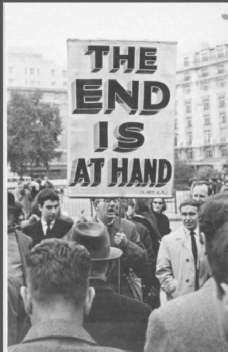
Having actually grown up in the 1950s, and having unlimited access now via the Internet to documentation of that time period, I find myself increasingly uncomfortable with the notion that it was God’s Decade. And that I am now living in the Devil’s Decade. I fear that many of my peers, and those in my daughter’s generation, are selling their own minds a bill of goods that is more based on a Disneyfied version of Mid-
But how could this be? Weren’t the Baby Boomers like me actually THERE to experience it? Well, in one way yes, and in one way—No. Where they all were … and where I was too… was in their own tiny little corner of the world of that time. And as children, they would have been quite unaware of most of the “rest of the world” at the time. So there are two things that can rose-
The first thing is that everyone’s memory is selective. We really don’t remember “everything” we experienced in our childhood in that little corner of our world.
For instance, there were 5,262,480 minutes (or so) in the decade of the 1950s. I have “independent memories” of what went on in only a very tiny portion of those minutes! There would be a few unpleasant crises in my young life that would stand out and be part of my memories of a few minutes or hours or days. There would be a few really positive high points that would stand out, such as a birthday or Christmas when I received some coveted item as a present. And of course there would be a collection of “Kodak Moments” that I may only remember because my family preserved them in photos.
For instance, I have absolutely NO memory of this event depicted below—that’s me in about 1955 sitting on the horse named Topper that belonged to famous movie and TV cowboy star Hopalong Cassidy. The horse (not Hoppy…) was making a personal appearance at some local shopping center to promote the TV show—or maybe some product that was sponsoring Hoppy’s show at the time. But because my mom snapped a pic of the occasion, I have sort of a pseudo-
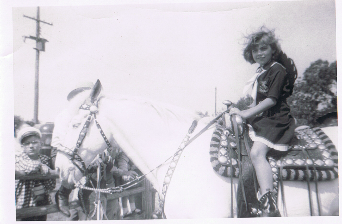
The other aspect of everyone’s thoughts in the past hundred years that leads to rose-
List the names of five boys who were in your third grade class in school.
Give the name of the mayor of your town when you were a high school freshman.
Give the last name of the family that lived two doors down from you when you were in sixth grade
How did you do? Not so well? Well, let’s try another little Name Game.
Name that Product
You’ll wonder where the yellow went when you brush your teeth with_______
See the USA in your ________
It builds strong bodies 12 ways. ______
A little dab’ll do ya. ______
Most Baby Boomers will get those trivia items … and a WHOLE lot more. Just add an advertising jingle or song to an item and you have an utterly “sticky” memory, that will likely last a lifetime. So a significant proportion of the “memories” we have of our youth … in this case, the 1950s … were formed not by “experiences” … but by manipulation by Madison Avenue!
And this is significant because in many cases a lot of our “perception” of what society was like as a whole in the 1950s is not based on personal experience. It is based on the images that were fed to us via TV shows, ads on TV and in magazines, and other media.
I am convinced in many cases we may have many utterly false memories of what a whole era was like in the real world because what we think are “real” memories were images manufactured by the media that we were exposed to—carefully chosen and crafted by experts in their fields to wheedle their ways into our subconscious.
When reminiscing about how godly and wonderful the society of the 1950s was, lots of folks with roots in that era will point to their memories of the TV show “Father Knows Best” as an example of how things were, and how far we’ve come from that ideal.
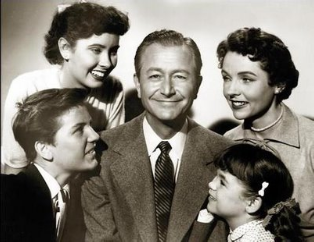
Jim and Margaret Anderson and their children, Bud, Betty, and little Kathy were touted back at the time as the perfect models for us all.
The problem is, Jim, who supposedly Knew Best, and his wife and offspring weren’t a family of the ‘50s. They were fictional characters! Invented by writers in Hollywood. They weren’t the “typical” family of the day. They were a Disneyfied version—appropriately, the show began in 1954, just a year before the Disneyland version of Main Street USA introduced the nation to Walt’s pseudo-
Which is surely true of the fictional Anderson Family—it was The Family That Never Was.
Because the REAL people who populated the screen sets for the show during its run from 1954 to 1960 were nothing like the Andersons. Elinor Donahue (“Betty”) managed to escape major issues. But the stories of the rest of the cast make it clear that the show wasn’t reflecting real life.
Robert Young (“Jim”): Young suffered from alcoholism and depression off screen during the show’s run. He had a nervous breakdown in 1966 and it took him nearly 4 years to recover. He attempted suicide in 1991.
Lauren Chapin (“Kathy”-
Billy Gray (“Bud”): Shortly after the show ended, Billy was arrested and sent to jail for a while for marijuana possession. Although he was never again in problems for drug matters, that single incident plagued him for years in terms of getting other acting roles.
Billy (now in his 70s) was probably the most honest critic of the show, insisting in interviews in later years that it was NOT either a good role model for families, nor an accurate reflection of family life and society in general in the 1950s. Here are some excerpts from a 1983 interview with Billy, from the Wikipedia mini-
I wish there was some way I could tell the kids not to believe it. The dialogue, the situations, the characters, they were all totally false. The show did everyone a disservice. The girls were always trained to use their feminine wiles, to pretend to be helpless to attract men. The show contributed to a lot of the problems between men and women that we see today. . . . I think we were all well motivated, but what we did was run a hoax. ‘Father Knows Best’ purported to be a reasonable facsimile of life. And the bad thing is, the model is so deceitful. It usually revolved around not wanting to tell the truth, either out of embarrassment, or not wanting to hurt someone. If I could say anything to make up for all the years I lent myself to (that), it would be, ‘You Know Best.’
He was even more candid in an interview in 1991. Check out this two minute Youtube clip.
Billy Gray (former 1950s youth actor) from 1991
When we “reminisce,” we need to ask ourselves … “Am I reminiscing about a reality, or about a Disney-